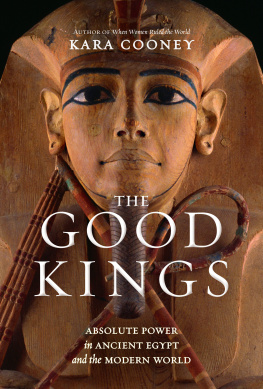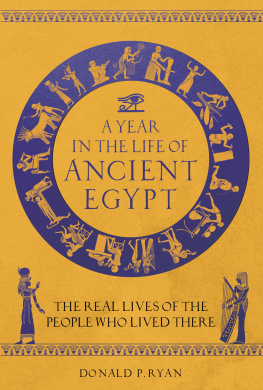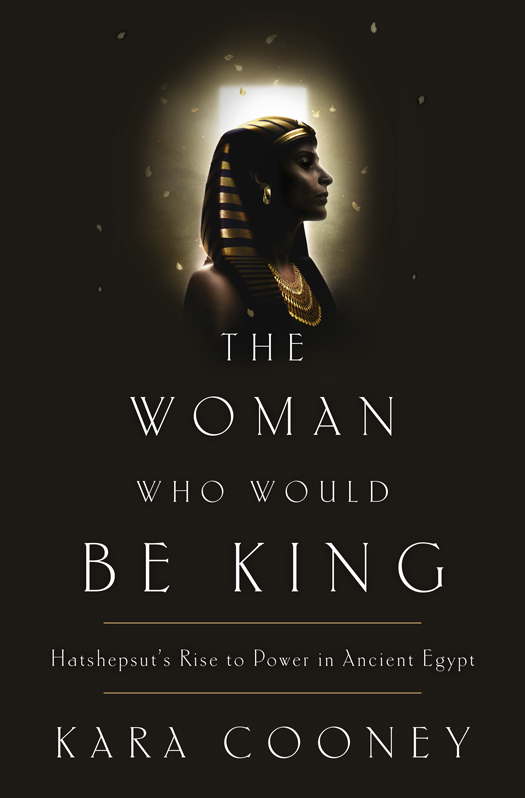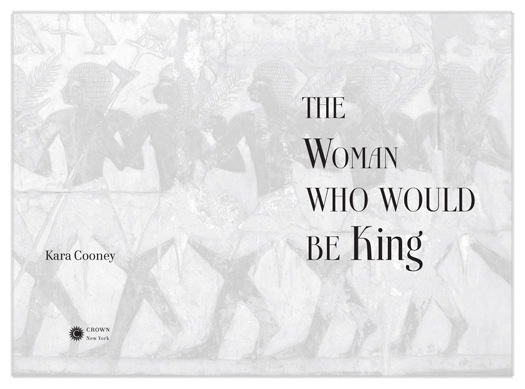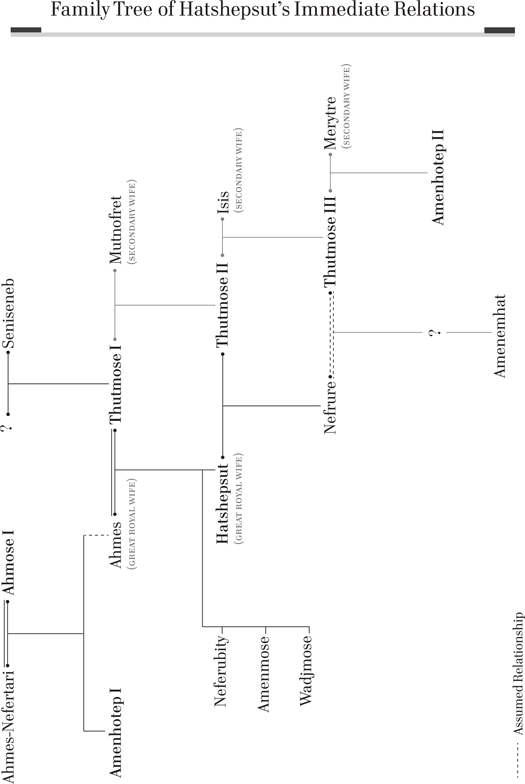Copyright 2014 by Kara Cooney
All rights reserved.
Published in the United States by Crown Publishers, an imprint of the Crown Publishing Group, a division of Random House LLC, a Penguin Random House Company, New York.
www.crownpublishing.com
CROWN and the Crown colophon are registered trademarks of Random House LLC.
Library of Congress Cataloging-in-Publication Data
Cooney, Kara.
The woman who would be king / Kara Cooney. First edition.
pages cm
1. Hatshepsut, Queen of Egypt. 2. QueensEgyptBiography. 3. PharaohsBiography. 4. EgyptHistoryEighteenth dynasty, ca. 15701320 B.C. 5. EgyptKings and rulersBiography. I. Title.
DT87.15.C66 2014
932.014092dc23
2014000243
ISBN 978-0-307-95676-7
eBook ISBN 978-0-307-95678-1
Map copyright 2014 by David Cain
Illustration on by Deborah Shieh
Jacket design by Chris Brand
Jacket photography by Sam Weber
v3.1
For Neil, with whom I have walked
through so many fires.
And for Julian, whose happiness
doesnt yet make him cry.
CONTENTS
CHRONOLOGY
| New Kingdom15391077 BCE |
| Eighteenth Dynasty | 15391292 BCE |
Ahmose I (Nebpehtyre) | 15391515 BCE |
Amenhotep I (Djeserkare) | 15141494 BCE |
Thutmose I (Aakheperkare) | 14931483 BCE |
Thutmose II (Aakheperenre) | 14821480 BCE |
Thutmose III (Menkheperre/Menkheperkare) | 14791460 BCE |
Hatshepsut (Maatkare) | 14721458 BCE |
Thutmose III (Menkheperre) | 14601425 BCE |
Amenhotep II (Aakheperure) | 14251400 BCE |
Thutmose IV (Menkheperure) | 14001390 BCE |
Amenhotep III (Nebmaatre) | 13901353 BCE |
Amenhotep IV/Akhenaten (Neferkheperure) | 13531336 BCE |
Smenkhkare/Neferneferuaten | 13361334 BCE |
Tutankhaten/Tutankhamen (Nebkheperure) | ?1324 BCE |
Itnetjer Ay (Kheperkheperure) | 13231320 BCE |
Horemheb (Djeserkheperure) | 13191292 BCE |
| Nineteenth Dynasty | 12921191 BCE |
Ramses I (Menpehtyre) | 12921291 BCE |
Seti I (Menmaatre) | 12901279 BCE |
Ramses II (Usermaatre setepenre) | 12791213 BCE |
Merneptah (Baenre) | 12131203 BCE |
Seti II (Userkheperure) | 12021198 BCE |
Amenmesses (Menmire) | 12021200 BCE |
Siptah (Akhenre) | 11971193 BCE |
Tawosret (Sitre merytamen) | 11921191 BCE |
| Twentieth Dynasty | 11901077 BCE |
Setnakht (Userkhaure) | 11901188 BCE |
Ramses III (Usermaatre meryamen) | 11871157 BCE |
Ramses IV (Heqamaatre setepenamen) | 11561150 BCE |
Ramses V (Usermaatre sekheperenre) | 11491146 BCE |
Ramses VI (Nebmaatre meryamen) | 11451139 BCE |
Ramses VII (Usermaatre setepenre meryamen) | 11381131 BCE |
Ramses VIII (Usermaatre akhenamen) | 1130 BCE |
Ramses IX (Neferkare setepenre) | 11291111 BCE |
Ramses X (Khepermaatre setepenre) | 11101107 BCE |
Ramses XI (Menmaatre setepenptah) | 11061077 BCE |
(Based on Erik Hornung, Rolf Krauss, and David A. Warburton, eds., Ancient Egyptian Chronology, Handbook of Oriental Studies, sec. 1, The Near and Middle East [Leiden and Boston: Brill, 2006].)
AUTHORS NOTE
Certainty plays little role in this history of Hatshepsut. The nature of the information passed down to us is uneven, and because so many of her monuments were destroyed, the jumble of perceptions we are left with are from other people, many of whom lived millennia after her death. I have had to break many rules of my Egyptological training in order to resurrect and reanimate Hatshepsuts intentions, ambitions, and disappointments, by engaging in conjecture and speculation, and creating untestable hypotheses as I attempt to fill out her character and decision-making processes (even though I document my sources and accentuate my uncertainties). Any supposition on my part is warranted, I believe, because Hatshepsut remains an important example of humanitys ambivalent perception of female authority. Even in the absence of exact historical details and reasons behind Hatshepsuts actions, I can still track her rise to power by following the clues left behind by herself, other kings, courtiers, officials, and priests, thus filling out the circumstances of her lifes journey as I go.
I have decided to forgo any long-winded analysis of architectural history, reliefs, statuary, text, and genealogy, instead focusing solely on Hatshepsuts narrative; you will find discussions of topics tangential to the main story in the notes. I have also eschewed reconstructions of Hatshepsuts ambitious building program, because the extensive evidence of it already fills many volumes. (Indeed, Hatshepsuts impressive architectural agenda has lured historians into creating a narrative of objects and buildings in lieu of a history of Hatshepsut herself.) This book is about a woman of antiquity and her interactions with Egyptian systems of government and power players, her decisions, her ambitions, her desperation, her triumphs, and her defeats. As I follow Hatshepsuts story from her ancestral beginnings to her bitter end, I will watch what she did and how she did it, within the context of her times, and present my hypotheses explaining her motivations and thought processes.
Many historians will no doubt accuse me of fantasy: inventing emotions and feelings for which I have no evidence. And they will be right. As I try to get at the human core of Hatshepsut, I will put many ideas and assumptions on the page; this is the best way for me to reconstruct her decision-making process. My conjectures, founded on twenty years of Egyptological research, are bounded and informed. What I say about Hatshepsuts emotions may not be right, but when I engage in conjecture, I do my best to qualify the statement, or to offer alternatives, or to clarify any uncertainty in my writing. The inexactitude remains, however, as is the case with any historical study of the ancient world.
This book is a kind of pause for me, something completely different from my previous Egyptological research dealing with funerary data sets and coffin studies. I have used all my skills as a researcher, but I have also allowed myself to think out loud, to infer and imagine, in a way I would not do in my other work. This book finds its origins in my intimate (and strange even to myself) connection to the ancient world, and I have to thank the countless scholars who share the same obsession with Egypts pastgenerations of archaeologists who uncovered Hatshepsuts remnants in the dirt, philologists who translated and analyzed her texts, art historians who pieced together broken statues and found traces of her relief erased by chisels. They have paved the way for this biographical discussion of Hatshepsuts relevance.


